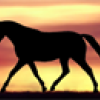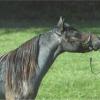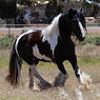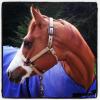Light dun markings
Forums
Re: Light dun markings
Thank goodness! I was hoping the test results were not accurate!
With her winter coat, you can't see the stripe except if you look at a certain angle.
I like that it's light, but was concerned about countershading.
How do these markings differ from counter shading?
Re: Light dun markings
[quote="Andrea"]I've been searching all over for duns with light light markings.
My yearling's markings are there, but so light. She's got a nice wide dorsal but it fades as it gets to her withers. [img]http://i100.photobucket.com/albums/m26/…]
[/quote]
Nuh I reckon she comes across as very dun, she's also very cute!!!
Re: Light dun markings
I would think that they are inheritable as opposed to random.
Let's see....
Countershading - 1. a form of adaptive camuoflauge where the coat color is darker dorsally; 2. a term applied to any pattern of darkened hairs in the coat color
Dun - a horse with the dun mutation
hm. I would imagine that both are inheritable. So one is camo, and one is a specific mutation.....?????
Re: Light dun markings
Andrea you didn't want her to be dun?
DunCentralStation's opinion is that EVERY horse has primitive markings. Dun does not cause primitive markings, it simply dilutes the coat AROUND the primitive markings leaving them obvious. Other genes have the potential to do this, but only rarely do they actually do it. Sooty seems to be attracted to the primitive markings and can darken them up and that's probably where you get the very noticeable countershading.
While she may be an example of horses we would normally call countershading actually being dun, this one tested non dun (still not sure I trust that test). It seems to swing both ways. At least yours has another dilute to explain the paleness of markings though.:
[img]http://www.accphotography.com/gallery/d…]
Re: Light dun markings
So really it is like a tabby cat, all horses have the dun markings but only the dun mutation and sometimes some others colours show them?
There is a girl who goes to the RDA where I volunteer who has a little chestnut arab mare with very noticable stripes on her legs.
Re: Light dun markings
Still haven't found an answer to her odd peach body color either (no sunbleaching, she's in during the day).
Re: Light dun markings
[quote="accphotography"]Andrea you didn't want her to be dun?
DunCentralStation's opinion is that EVERY horse has primitive markings. Dun does not cause primitive markings, it simply dilutes the coat AROUND the primitive markings leaving them obvious. Other genes have the potential to do this, but only rarely do they actually do it. Sooty seems to be attracted to the primitive markings and can darken them up and that's probably where you get the very noticeable countershading.
While she may be an example of horses we would normally call countershading actually being dun, this one tested non dun (still not sure I trust that test). It seems to swing both ways. At least yours has another dilute to explain the paleness of markings though.:
[img]http://www.accphotography.com/gallery/d…]
[img]http://www.accphotography.com/gallery/d…]
[img]http://i173.photobucket.com/albums/w65/…]
This is Lacy, and she tested neg for Dun?
Re: Light dun markings
Indeed.
In fact her paperwork got lost at UC Davis for a bit because the person that had run the test was surprised it was negative based on her photo and put it on the supervisors desk for him/her to double check. They found it when I called to ask but apparently the supervisor decided to go with non dun anyway.
Re: Light dun markings
Hmmmmm.... yeah that sounds like possibly they got the wrong result, he dorsal stripe is light but distict.....she doesn't have any of the primitive marking on her legs but I know in red duns they can be very light, on her legs Annies don't show well in the winter but in the summer they show sho pretty well but still light, that is because her summer coat is much lighter than her winter coat.
[img]http://i785.photobucket.com/albums/yy13…]
Summer
[img]http://i785.photobucket.com/albums/yy13…]
Winter
[img]http://i785.photobucket.com/albums/yy13…]
Re: Light dun markings
Well you were saying that the theory is that the coat is diluted around the base coat so if the base coat is really light then maybe that's why they dont show up as well somtimes. Annie is redder, she looks like a chestnut to me in the winter but in the summer she looks red dun to me because her legs bars and dorsal stripe shows up so much better and her coat does get pretty light and creamy looking.
Re: Light dun markings
Red Dun no cream Paso Fino mare
http://i55.photobucket.com/albums/g139/…" onclick="window.open(this.href);return false;
http://i55.photobucket.com/albums/g139/…" onclick="window.open(this.href);return false;
http://i55.photobucket.com/albums/g139/…" onclick="window.open(this.href);return false;
http://i55.photobucket.com/albums/g139/…" onclick="window.open(this.href);return false;









Re: Light dun markings
This is a proven dunskin and those who have seen him in person say there is no hint of dun.
http://www.sunnybrookranch.com/Slicks%2…" onclick="window.open(this.href);return false;